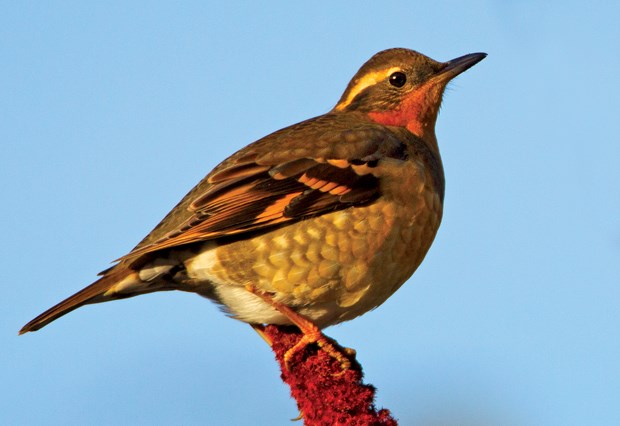Feeder watchers know there's been an "invasion" of sorts: pine siskins have again shown up in big numbers.
These striped finches with yellow wing bars are related to goldfinches. At bird feeders siskins love to feed on black oil sunflower seed or nyger (sometimes called thistle). In the wild, siskins are often seen in alder trees, feeding on the seeds. You can listen for them with their distinctive "wheezy" voice. John Neville and Mel Coulson, in their wonderful CD set, Beginners Guide to B.C. Bird Song, describe the siskin's voice like someone drawing their thumb across a plastic comb. In some years, there are what Bill Thompson III (The New Birder's Guide to Birds of North America) calls "invasion winters when thousands of pine siskins come south for food."
An excellent spot to watch for winter finches like siskins is the new feeding station at the Conservation Area at Maplewood Flats. I mentioned that siskins often associate with goldfinches, but they also are seen with other birds like redpolls. Our local species, the common redpoll, is somewhat siskin in appearance but with a reddish cap ("poll") and a pinkish breast. Redpolls should be looked for not only at feeders, but also in birch and alder trees.
There is another redpoll on the local (Great Vancouver) checklist called the hoary redpoll. It is very rare locally, but we should always be on the alert for the unusual. There's no telling what feathered wonders will show up. Look at Victoria recently with its redwing, a Eurasian thrush.
Speaking of thrushes, the beautiful varied thrush has appeared in good numbers around feeders, gardens and woods this winter. This mountain thrush, it is often noted, makes a downward migration when the snow builds up on local mountains, although they also are seen by snowshoers and cross-country skiers at higher elevations.
The voice of the varied thrush is described variously as a "hum-whistle" given the varying levels - hence the name, varied. And yet, no words can describe its lovely voice, but once you hear it, you'll never forget it. Back several decades ago, the
varied thrush was the choice of many birders for B.C.'s official bird, but the Steller's jay won.
Some bushes and trees like hawthorns and native Pacific crabapple retain their fruits well into winter providing food for many birds, like the varied thrush, robin, waxwings and pine grosbeak. Two waxwing species occur on the North Shore, the cedar waxwing and the Bohemian waxwing. These lovely crested birds look very similar but the Bohemian has rusty colour under its tail (under tail coverts). It gets its name from its nomadic or Bohemian habits.
Along with waxwings and thrushes, keep watch in the bushes for other birds like pine grosbeaks, spotted towhees and northern flickers. They all love the fruit, especially wild crabapple.
Our common local flicker is called the red shafted flicker, but once in a while an eastern yellow-shafted flicker will appear. At one time these flickers were regarded as separate species, but then they were "lumped." That is the official term and the opposite is "splitting."
The yellow "shaft" refers to wing linings (golden), whereas the "red shafted" refers to salmon-coloured wing linings. The red shafted flicker male has a red moustache (malar), while the yellow shaft's moustache is black. The yellow shaft also has a red patch on the back of its head. Watch for birds with a combination of these field marks - these are known as intergrades, and not hybrids because they are not the offspring of two species.
An interesting feature of winter birding is seeing mixed flocks composed of chickadees, nuthatches, woodpeckers, creepers and more. Stephen Kress (Bird Life - A Guide to the Behaviour and Biology of Birds) notes that, "such flocking helps birds avoid predatory hawks, for many eyes are watching." Sometimes, you will even find a wintering yellow-rumped warbler or a Hutton's vireo in the roving flock.
On crisp sunny days of winter it is wonderful to be out enjoying the North Shore's diversity of wildlife. Keep safe, dress warmly and watch the weather.
Al Grass is a naturalist with Wild Bird Trust of British Columbia, which offers free walks at The Conservation Area at Maplewood Flats on the second Saturday of every month. The next walk will be Saturday, Jan. 9 starting at 10 a.m. Participants will be looking and listening for the birds that spend the winter in the area. Meet at WBT's site office, 2645 Dollarton Hwy, North Vancouver. Walks go rain or shine. wildbirdtrust.org



